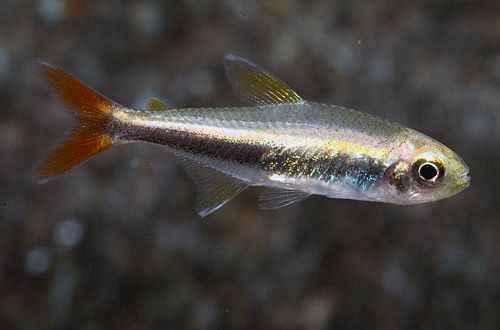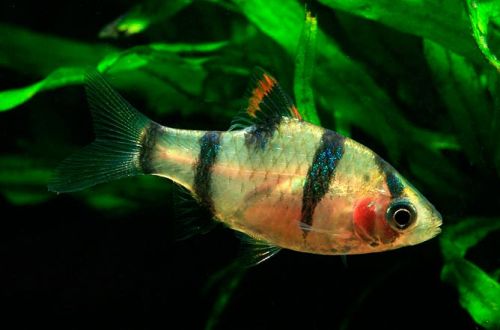
Tetra Loreto
Tetra Loreto, scientific name Hyphessobrycon loretoensis, belongs to the Characins family. The fish is named after the northeastern region of Peru – Loreto, where it was first discovered. Unpretentious and easy to maintain, easy to breed, compatible with other freshwater fish species.

Contents
Habitat
It comes from South America from the upper Amazon basin from the territory of southern Colombia, Peru and Ecuador. Inhabits small streams and rivers flowing among equatorial forests. Such habitats are characterized by large amounts of overhanging riparian vegetation, submerged branches, tree roots and leaf litter. Water, as a rule, acquires brown shades due to the abundance of substances formed as a result of the decomposition of plant organic matter.
Brief information:
- The volume of the aquarium – from 40 liters.
- Temperature – 22-28°C
- Value pH — 5.0–7.0
- Water hardness – 1–10 dGH
- Substrate type – any
- Lighting – subdued
- Brackish water – no
- Water movement is weak
- The size of the fish is about 2 cm.
- Feeding – any food of suitable size
- Temperament – peaceful
- Keeping in a group of 8-10 individuals
Description
Adult individuals reach a length of about 2 cm. Sexual dimorphism is weakly expressed, males and females do not have pronounced differences. Coloration gray-silver. A wide dark stripe runs along the body, framed on top with a golden stroke. The base of the tail is reddish.
Food
An omnivorous species, it accepts various foods such as dry food in the form of flakes, pellets, live or frozen brine shrimp, daphnia, small bloodworms or pieces thereof. Feed particles should be small. Feed 2-3 times a day in the amount eaten in 5-10 minutes.
Maintenance and care, arrangement of the aquarium
The optimal size of the aquarium for a flock of 8-10 fish starts from 40-50 liters. The design is arbitrary, however, Tetra Loreto will look most harmonious in an environment reminiscent of a natural habitat, among snags and thickets of aquatic plants. The leaves of some trees are also used for decoration. In addition to the design function, they allow you to give water a chemical composition similar to that in which fish live in natural reservoirs, due to the release of tannins in the process of decomposition.
When keeping, it is important to ensure stable water conditions in a suitable range of temperatures and hydrochemical values. Sharp fluctuations in pH / dGH parameters and the accumulation of dangerous concentrations of nitrogen cycle products (ammonia, nitrites, nitrates) should not be allowed. Achieving and maintaining a balance in the aquarium ecosystem largely depends on the regularity of its maintenance, the operation of the filtration system and other equipment.
Behavior and Compatibility
Peaceful schooling fish, it is desirable to support in the community of relatives. The minimum group size is 8–10 individuals. Compatible with other non-predatory and non-aggressive species of comparable size.
Breeding / reproduction
Under favorable conditions, spawning is possible throughout the year. There is no seasonality, so if there are several dozen fish, it is likely that fry will appear every month.
Females scatter eggs among thickets of plants or directly in open space on the ground, and males at this moment fertilize them. Parental instincts are not developed, there is no care for offspring. In addition, adult fish, on occasion, will certainly eat eggs and fry that have appeared.
If breeding is planned, then the fertilized eggs should be moved to a separate tank. It can even be an ordinary three-liter jar filled with water from the main aquarium, equipped with a simple airlift filter with a sponge and a heater. No light source required.
Since juveniles are very small, specialized powdered products or live microorganisms, such as shoe ciliates, should be used as feed.
Fish diseases
Diseases inherent in this particular species of fish were not noted. When kept in suitable conditions (high water quality, balanced diet, non-conflict neighbors, etc.), health problems are not observed. The most common cause of disease is the deterioration of conditions leading to immune suppression, which makes the fish susceptible to infections that are invariably present in the surrounding area. When the first signs of an illness are detected (lethargy, exhaustion, refusal of food, lowered fins, etc.), it is necessary to immediately check the main parameters of the water. Often, the restoration of acceptable living conditions contributes to self-healing, but if the fish is too weak or has received obvious damage, medical treatment will be required. For more information on symptoms and treatments, see the Aquarium Fish Diseases section.





